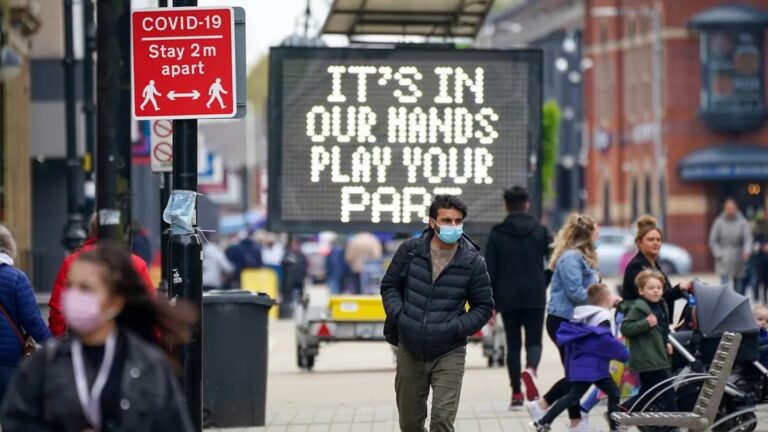Did you know last month featured the four-year anniversary of the first Covid clampdown?
Unless you’re a neurotic news hound scrolling Twitter all day for flash-in-the-pan stories that tickle your priors, probably not. Our base-ten mentality overlooks numbers that don’t end in five or zero. Maybe an anchor on your local nightly newscast mentioned the marking in passing. Or your RN cousin posted a clipped memory of her choreographed dance with other scrubbed orderlies as someone’s grandfather coughed himself to death in the background.
There was a smattering of articles on the tetra-versary, some with a human-interest “where are they now” angle like The New York Times. CNN dished a morbid reminder that over a million Americans perished from Covid while, mere sentences later, hyping Trump versus Biden redux. ADHD news pub Axios published a big-sounding “The day everything changed” account for March 11, the fateful calendar point when the China-gimped World Health Organization declared a pandemic, before bathetically bullet-pointing some stats intermixed with saccharine palaver like “[i]t briefly brought Americans together in a moment of shared sacrifice.”
President Biden probably tossed off some Covid remembrance post, touting his administration’s vaccine—really, precautionary therapeutic—distribution effort and nominally good economic recovery data. Vice President Harris also likely followed it up with a tribute to the million-plus body count interspersed with ear-scarifying giggling and Venn diagram paeans. (“You know, I love Venn diagrams. You put Covid in one circle, a million dead in another, and put them together to get… HAUH HAUH HAUH HAUH HAUH you get a pandemic, right?!”)
Even though he boils my blood and will probably one day give me a coronary occlusion from hate-reading his dull-witted takes, wonk-journo Matt Yglesias had a surprisingly candid analysis on the pandemic’s quad birthday. In “17 thoughts four years after Covid,” Yglesias quibbles with counterfactuals, such as what if the U.S. took Sweden’s non-lockdown approach. He even offers a fun thought-scenario where President Trump, whose spotty, hypocritical, and weird ambivalence on Covid-driven social-limiting decrees made everyone question everything, actually went full-bore street-cleaner in face of the George Floyd riots. By forcefully (maybe even unconstitutionally) curtailing the mayhem that engulfed many cities, Trump might have saved black lives from Black Lives Matter agitants. And perhaps rescued his re-election bid too.
Guess we’ll never know.
Tucked away in one of Yglesias’s contentions is a profound point: “One of the most surreal aspects of the Covid experience, to me, was reading a lot of media coverage that seemed to presume that the experience of being a highly Covid-cautious teleworker was typical, when in fact most working-age people were doing in-person jobs the whole time.”
He links back to a piece from May 2021, not long after the first mRNA ampoules hit your local pharmacy, recording his own experience enduring the first Covid winter, which sounds relatively routine: work-from-home, staying vigilant, occasionally venturing out to the grocery store, doing everything possible to be in the well-ventilated outdoors when meeting friends.
Except that’s the opposite experience of most working Americans. In April of the same year, less than 20 percent of the workforce was banging out the grueling 9-to-5 in an ergonomic computer chair, slumly appareled in sweatpants and hoodies. Count me among the slovenly fifth, keying away my days from the comforts of my basement. Meanwhile, three quarters of workers were actually braving the respiratory pathogen, sharing breathing room with coworkers and customers. And I bet not all of them were rubber banding n95 snugly to their mandibles.
But which personal experience did we hear, see, visualize, and have formed in our imagination more? That of the exposed factotum unloading goods from tractor trailers? Or of the high-prole desk jockey hosting pitiful Zoom “happy hours,” fashioning an ersatz social life?
If memory serves—and our collective recall is admittedly spotty for the first plague year—the impression the media created was that most American workers were able to grub away at home, the water cooler replaced with bobble-head chats.
The laptop class was presented as the only class keeping the country humming while everyone waited for…what exactly? Dr. Fauci as Godot? A jab that doesn’t actually prevent transmission? The governor to announce we’re allowed to buy seeds or saddle up to a bar again? A bonafide miracle in the form of a divine Hoover to suck SARS-CoV-2 from the earth?
Casting a backward glance, I can’t really remember what deliverance we wished for. If I’m being honest, surviving shutdown-year-one was a relatively pleasant experience. I had a remote job before Covid, so I kept clocking happily in, even with a decreased workload. With the added free time in the afternoon, I pushed my one-year-old around our hillocky neighborhood in her Step2 hot pink car, quaffing IPAs like a reverse fire hose while treating the neighbors to Artie Shaw hits from a Bluetooth speaker. We paid for the germ sabbatical later. But otherwise, there wasn’t much to carp about. Just lots of jokes about not wanting to socialize anyway and how I’d go long stretches in stretchy pants, putting my legs through a pair of khakis once every few months.
My experience, which was common among Twitter newsmakers, wasn’t actually common, though. Most Americans kept up the good commercial fight, stocking stores, working in close quarters, playing matador to the virus, which, at the time, seemed far deadlier than it actually was for healthy people. Horror stories of line workers dropping dead in loosely regulated factories popped up occasionally—a few of which were predictably exaggerated because it was an election year. Some mega-businesses were shamed for lax sanitary protocols and pathetic care packages like a mask with a mini candy cane. But they were only muddling through like everyone else.
I was not among the toiling in-person ranks thanks to an old Marxist privilege known as class. The upper-sedentary class—“professionals who traffic in data, idea, rhetoric, and images” as Musa al-Gharbi calls them—was spared thanks to the blessing of the internet. Consider this column a long-winded way of checking my privilege four years on.
Now, with my privilege thoroughly checked, where do I apply for reparations? Is that how this works?














True enough. My life was oddly unchanged throughout most of the declared crisis as I marched around my habitual rabbit paths maskless and proud. In deference to the wishes of an astonishingly small number of encounters of zealot kind I wore a converted sheetrock mask to intimidate grocery shoppers into silence as I picked up the occasional cabbage at the vegetable isle with loud Darth Vader like inhalations. Good Times!